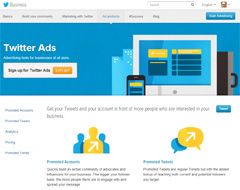Twitter now offers advertising.
It’s no secret that companies spend plenty of marketing dollars on advertising through Facebook, Google, etc. If you’ve ever conducted a Google search or seen those presumptuous directed plugs on the side of your Facebook newsfeed, then you’re familiar with the noise. When it comes to social advertising, you’d think that Twitter plays a pretty big role, but its footprint is pretty small (at least when compared to the big guys). It begs the questions:
- Why does Twitter lack advertising interest?
- Should your business give it a try?
- How can you make the most of the decidedly short-form audience on Twitter?
Twitter And Advertising Interest

12 keys, a rehab facility, invest a substantial Facebook advertising budget that includes PPC, A/B testing, and a budget for non-profit initiatives. Facebook has the reach, customizability, and flexibility needed to reach specific target demographics. Twitter doesn’t have that capability yet.
Another confounding factor for Twitter ads is a bit less cut-and-dry. The service is so new that people just aren’t paying too much attention to it now. This could be the reason for the lack of interest, or the lack of interest could be because the platform simply isn’t enticing enough. It remains to be seen. Bear in mind that while it isn’t an avenue that major brands are trying just yet, it could grow as time goes on.
Why Should Your Business Do Advertising On Twitter?
After establishing that brands like Nike, Honda, Kellogg’s, etc. might not be super impressed with the reach of Twitter’s web ads, it’s worth mentioning that these guys have massive marketing budgets and choose to dump them into other channels (not the least of which might be a multi-million dollar TV buy).
How does this play out for the Internet startups or the corner bakeries? The bottom line is that everything is worth a try when it comes to marketing tools. If you’re budget is $500 a month (for advertising alone), then you might as well try putting $100 down on Twitter. Your reach, in and of itself, is already pretty small. So every purchased channel is a new set of eyes, and a new group of potential customers.
Another interesting factor to note is, again, that the service is so new. For larger brands, money is spent better elsewhere. But for a younger company, now’s the time to capitalize on the just-starting-out click-rates that Twitter offers. They will most likely go up with time, requiring you to pay more money for less ad impressions. Plus, you want your business to be on the cutting edge, right?
Getting Started With Twitter Ads
You’ve made your decision to advertise on Twitter, and maybe you’ve even tried your hand at Google AdWords and Facebook marketing. The nuts and bolts remain fairly similar. You can promote your entire account or you can promote individual Tweets. The pricing is based on when action is taken on those promoted media (i.e. when someone follows your account or interacts with a Tweet you’ve promoted).
As with Facebook and Google, there are analytics. They aren’t quite as demographically robust as Google’s (as you’re really only capturing information about your customers’ Twitter accounts and activities), but it’s a powerful tool for determining whether your purchased campaigns are landing you the right kind of traffic.
The biggest difference for Twitter marketing surrounds their all-but-proprietary concept of “trending topics.” If a user adds a phrase at the end of their post with “#” in front, then that phrase is searchable, categorizable and, most importantly, measurable and targetable. These “hashtags” fuel the living, breathing network that is the Twittersphere.
If organically growing a hashtag for marketing purposes seems too daunting a task for you, Twitter allows for you to promote a hashtag. This gives it priority placement on various pages. If you’re curious about that, log into your Twitter account and look to the left-hand side. You’ll see some trending topics that are marked as “promoted.” These are examples. Bear in mind, though, that these can be really expensive depending on how far their reach is. But, it’s something that’s worth looking into.
Takeaways
That’s a rundown of Twitter advertising in an (extremely small) nutshell. Like any other expenditure, it’s really up to your business model whether it fits into your budget. But, if you’re promoting posts on Facebook and paying for keyword-trigger Google Ads already, then Twitter promotions are definitely worth a second thought. Who knows, you could promote a tweet and its hashtag could take off as the next big thing. How do you think millions of impressions created organically from a hashtag fit in against the $50 you spent promoting that original tweet?
Savannah Marie is a writer and social media junkie from New York. She is the editor of her blog, Mixios which features content about business, social media, online marketing, and whatever is trending. Follow her on twitter: @savfmarie
Comments are closed.